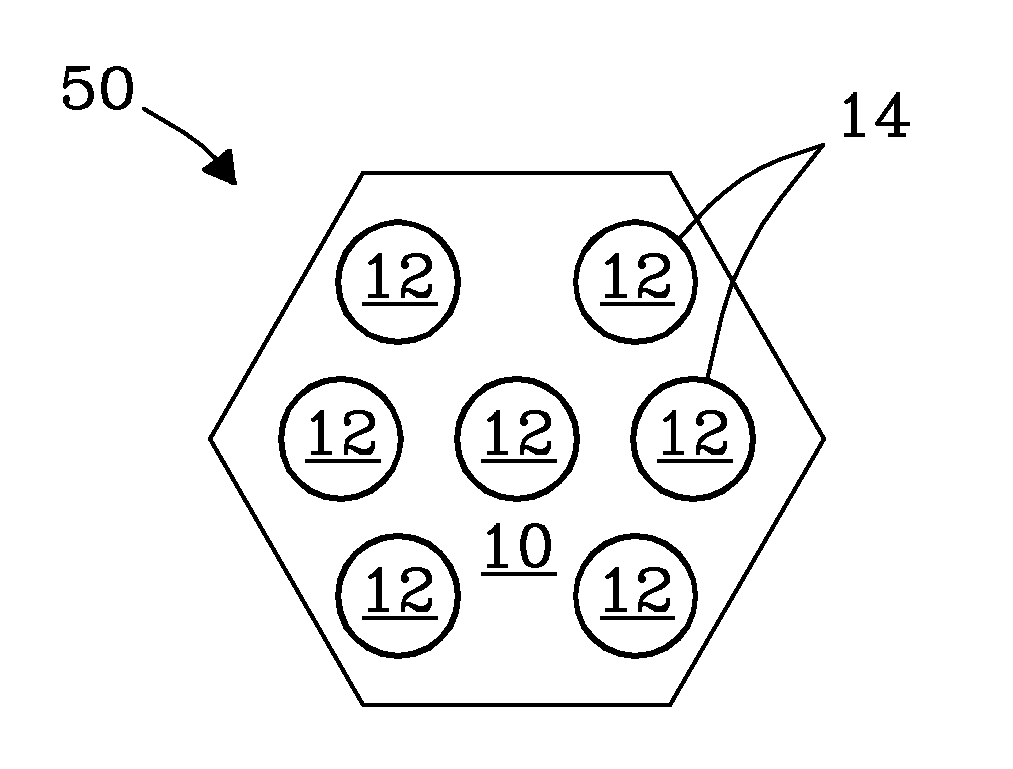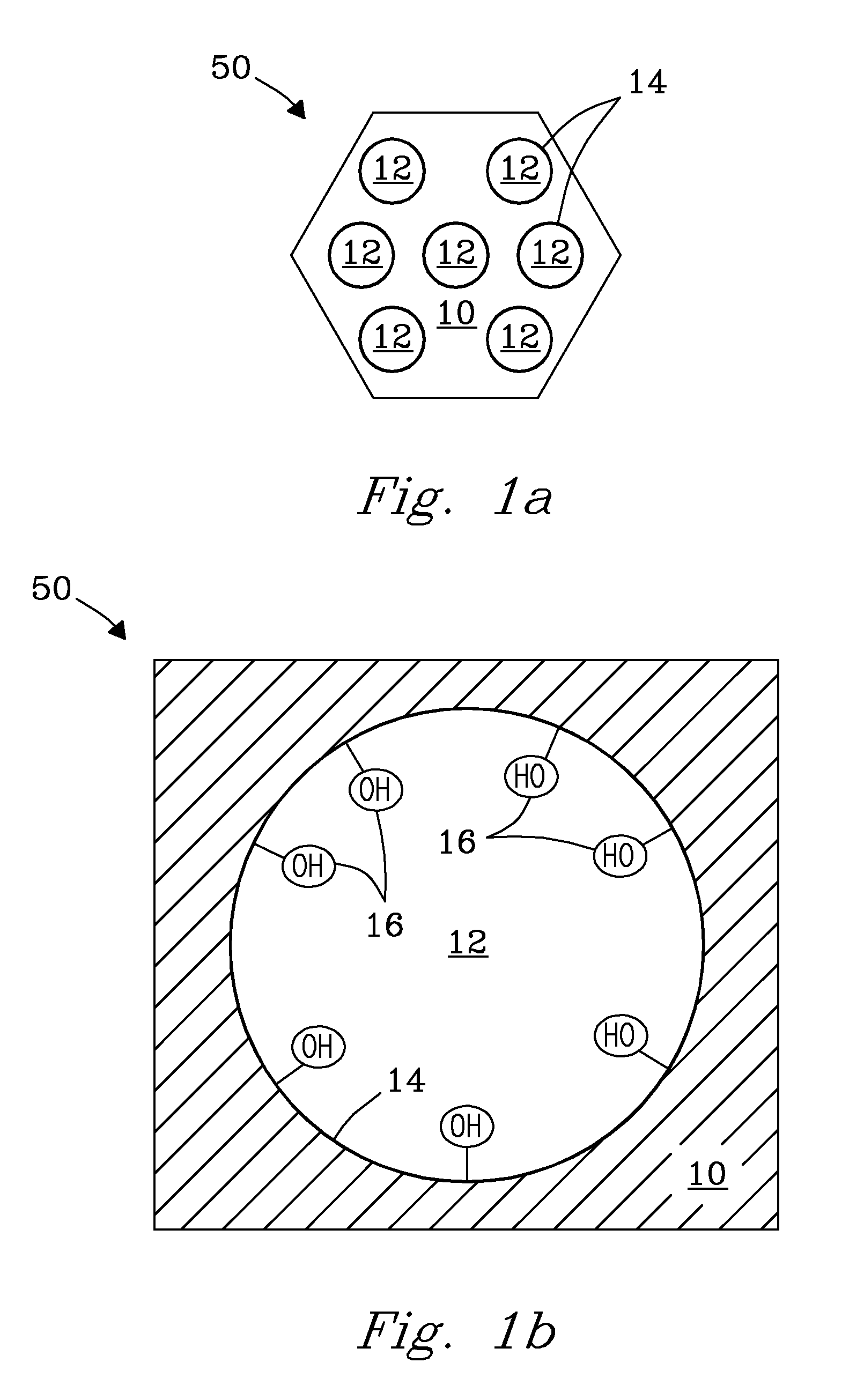[0004]The invention in one aspect is a sequentially functionalized, solid-state sorbent for chemical sorption that provides for capture and retention of preselected target analytes. The sorbent includes: a porous support (substrate) of a preselected porous material that includes pores of a preselected size, pore volume, and surface area. The porous support is composed of a preselected material including, but not limited to, e.g., metals, transition metals, main group metalloids, metal oxides, ceramic oxides, oxide coated materials, metal silicates, including combinations of these porous materials. Metals include, e.g., aluminum (Al), and tin (Sn). Transition metals include, but are not limited to, e.g., titanium (Ti), zirconium (Zr), zinc (Zn), iron (Fe), nickel (Ni), copper (Cu), including combinations of these metals. Main group metalloids include, but are not limited to, e.g., Si, Ge, As, Sb, Bi, including combinations of these metalloids. Metal oxides include, but are not limited to, e.g., Al2O3, Ga2O3, GeO2, SnO2, and combinations of these oxides. Ceramic oxides include, but are not limited to, e.g., SiO2 and TiO2. The porous support includes pores with a pore size of from about 30 Å to about 500 Å. The porous support further includes a pore volume that is greater than or equal to about 0.5 cc / g. More particularly, the pore volume is in the range from about 1 cc / g to about 3 cc / g, but is not limited thereto. Porous support includes a specific pore surface area greater than or equal to about 150 m2 / g. More particularly, specific pore surface area is in the range from 200 m2 / g to about 1500 m2 / g. Pores' of the porous support are functionalized with a preselected quantity of short-length (e.g., 5-20 Å) amino silanes that are chemically attached to surfaces (e.g., walls) of the pores, and substantially evenly distributed within the pores. In various embodiments, the short-length amino silanes include a terminal amine group. In one embodiment, the terminal amine group includes diethylenetriamine (DETA). In one embodiment, the short-length organic amino silane is 3-diethylenetriamine (DETA)-propyltrimethoxysilane. Short-length organic amino silanes preferably have a molecular weight of less than about 300 g / mol. Pores of the porous support further include a preselected quantity of organic polyfunctional oligomeric amino silanes (e.g., 25-45 Å) that are chemically attached to surfaces within the pores and interspersed between previously attached short-length amino silanes. The polyfunctional oligomeric amino silanes are substantially evenly dispersed across the pore surface within the pore. In one embodiment, the terminal group of the polyfunctional oligomeric amino silanes includes polyethyleneimine (PEI). In various embodiments, the polyfunctional oligomeric amino silanes have a molecular weight of from about 200 g / mol to about 1000 g / mol, but molecular weight is not limited thereto. Pores of the support further include a quantity of other short-length (e.g., 5-20 Å) amino silanes of like or different kind that are interspersed and chemically attached between previously attached short-length amino silanes and previously attached polyfunctional oligomeric amino silanes that serve to backfill open locations across the surface of the pores, forming the fully functionalized sorbent. The short-length organic amino silanes and organic polyfunctional oligomeric amino silanes in combination define a three-dimensional structure of active binding sites that are oriented substantially orthogonal to surfaces of the pores of the support. Crosslinking of silane groups between the short length organic amino silanes and the organic polyfunctional oligomeric amino silanes at the surface serves to maintain the 3-dimensional structure of amino silanes within the pores and further provides thermal stability of the solid-state sorbent. Amine functional groups present on the backbone of the highly functionalized silanes of the sorbent define active binding sites that provide the sorbent with a preselected functional density, selectivity, and capacity for retention of preselected target analytes. Functional density of the sorbent is defined by at least 3 or more amine functional groups per square nanometer of sorbent surface area. The density of active binding sites provide a preselected selectivity and capacity to selectively sorb, bind, capture, and retain preselected target analytes on the porous support of the sequentially functionalized sorbent when contacted by the analytes, including, e.g., gaseous analytes. Gaseous analytes include, but are not limited to, e.g., HCl, SO2, SO3, CO2, and combinations of these gases. In various embodiments, the binding sites of the sorbent can be further modified to include various functional groups including, but not limited to, e.g., thiols, carboxylates, sulfonates, phosphonates, phosphines, heteroaromatic ligands, ammonium salts, phosphonium salts, and combinations of these functional groups to provide selective binding for various target analytes. Heteroaromatic ligands include, but are not limited to, e.g., pyridines; 1,10-phenanthroline; 2,2′-bipyridine; and combinations of these ligands. The sorbent can be functionalized in various organic solvents, in supercritical fluids, or in the vapor phase. The sorbent can be used as a component of a sorption system or device, e.g., for trapping unwanted gases in a flue gas stream. The sorbent can also be used as a component of, e.g., analysis devices and applications, assay devices and applications, chemical separations devices and applications, including, e.g., biomedical devices and applications. No limitations are intended.
[0005]In another aspect, the invention includes a method for making a sequentially functionalized sorbent that provides for capture and retention of preselected analytes. In one functionalization step, pores of the support are pretreated and functionalized with a sub-monolayer quantity of a short-length (e.g., 5-20 Å) organic amino silane that is chemically attached to surfaces (e.g., walls) of the pores, and substantially evenly distributed within the pores. The pretreatment with short-length amino silane passivates the surface to allow passage and diffusion of other molecules larger than the short-length amino silanes into the pores of the porous support. In various embodiments, the short-length organic amino silane is an aminoalkylsilane selected from the group consisting of: aminopropylsilanes; and 3-(2-aminoethyl)aminopropylsilanes; 3-(diethylenetriamine)-propylsilanes, including combinations of these silanes. In a preferred embodiment, the short-length amino silane is a diethylenetriamine (DETA) amino silane. In another embodiment, the short-length organic amino silane is 3-diethylenetriamine (DETA) propyltrimethoxysilane. In a preferred embodiment, the sequentially functionalized sorbent includes short-length organic amino silanes with a molecular weight less than about 300 g / mole. The step of pretreating includes chemically dispersing short aminoalkylslane molecules throughout the porous support in a sub-monolayer quantity, and then subjecting them to hydrolysis / condensation chemistry to chemically attach them to surfaces within the pores. This pretreatment step enables functionalization in subsequent functionalization steps to include larger aminosilane molecules to percolate easily throughout the porous support by saturating hydroxyl groups located at the surface of the pores through an acid / base interaction with the amine backbones of the aminosilanes introduced the pores. The step of pretreating includes heating the porous support at a temperature of from about 50° C. to about 150° C. In one embodiment, the step of pretreating includes use of a quantity of the short-length amino silane that is between about 10% and 50% of the monolayer quantity. In another embodiment, the step of pretreating includes use of a quantity of the short-length amino silane between about 5% and 50% by weight of the monolayer quantity. In another (sequential) functionalization step, pores of the support are functionalized with a preselected quantity of an organic polyfunctional oligomeric amino silane (e.g., 25-45 Å) that is deposited, and chemically attached, to surfaces within the pores and interspersed between previously attached short length amino silanes such that they are substantially evenly dispersed across the pore surface within the pore. In various embodiments, polyfunctional oligomeric amino silanes include an aminated terminal group including, e.g., polyethylene imines; aminodendrimers; aminated polymers; aminated chitosans; aminoethylcelluloses; aminomethylpolystyrenes; and combinations of these amines. In a preferred embodiment, the polyfunctional oligomeric amino silane is a polyethyleneimine (PEI) silane. In one embodiment, the polyfunctional oligomeric amine silane includes polyethylene imine (PEI) that has been chemically modified to include a propyltrimethoxysilane anchor. In another embodiment, the step of depositing includes use of a polyethyleneimine (PEI) silane that is deposited using a method of incipient wetness (i.e., uses concentration solution) to occupy about 90% of the total pore volume of the porous support sample. In another functionalization step, pores of the support are backfilled with a preselected quantity of another short-length amine of like or different kind that chemically attach to the surface within the pores, backfilling the pores. Backfilling orients both short-length amines and polyfunctional oligomeric amines substantially orthogonal- to the surface forming a three-dimensional structure of active binding sites defined by amine groups on the silanes attached at the surface that provide the sorbent with a preselected functional density, selectivity, and capacity for capture and retention of target analytes. In various embodiments, the step of backfilling includes use of a short-length amino silane selected from: aminopropylsilanes; 3-(2-aminoethyl)aminopropylsilanes; 3-(diethylenetriamine)-propylsilanes; including combinations of these silanes. The step of backfilling includes crosslinking between adjacent siloxane groups located on the various short-length amino silanes and organic polyfunctional oligomeric amino silanes chemically attached at the surface that serves to maintain the 3-dimensional structure of active binding sites within the pores of the sorbent. The sorbent has a demonstrated sorption capacity for CO2 that yields a residual concentration of CO2 in air of below 0.01% in a time of less than one second. The deposition of polyfunctional oligomeric amine silane polymers is accomplished by chemically modifying the amine with an organosilane coupling agent. In various embodiments, the organosilane coupling agent includes, but is not limited to, e.g., 3-isocyanatopropyltrialkoxysilanes; 3-chloropropyltrialkoxysilanes;3-bromopropyltrialkoxysilanes; 3-iodopropyltrialkoxysilanes; 2-isocyanatoethyltrialkoxysilanes; 2-chloroethyltrialkoxysilanes; 2-bromoethyltrialkoxysilanes; 2-iodoethyltrialkoxysilanes; 4-(chloromethylphenyl)trialkoxysilanes; including combinations of these coupling agents. The step of back-filling is accomplished by a subsequent treatment of the pretreated support with a short-length aminoalkylsilane that fills in defects left over from the polymer deposition. The net result of these 3 sequential treatment steps is a higher overall functional loading than is possible with standard coating methods using typical amine terminated silanes. In one embodiment, the polyfunctional oligomeric amine is PEI and the polyfunctional oligomeric aminosilane is PEI silane. The sequentially functionalized sorbent provides a sorption capacity for target analytes that is from 2× to 3× greater than possible with sorbents made using standard coating methods using typical amine terminated silanes. The sequentially functionalized sorbent of the invention has a sorption capacity that can deplete concentrations of gas-phase target analytes. In one embodiment, the sequentially functionalized sorbent removes CO2 to below 0.01% in less than one second. Time to capture a gas phase analyte is dependent on the selected analyte specific gas, and the molecular weight of the gas. Thus, no limitations are intended.
 Login to View More
Login to View More 


